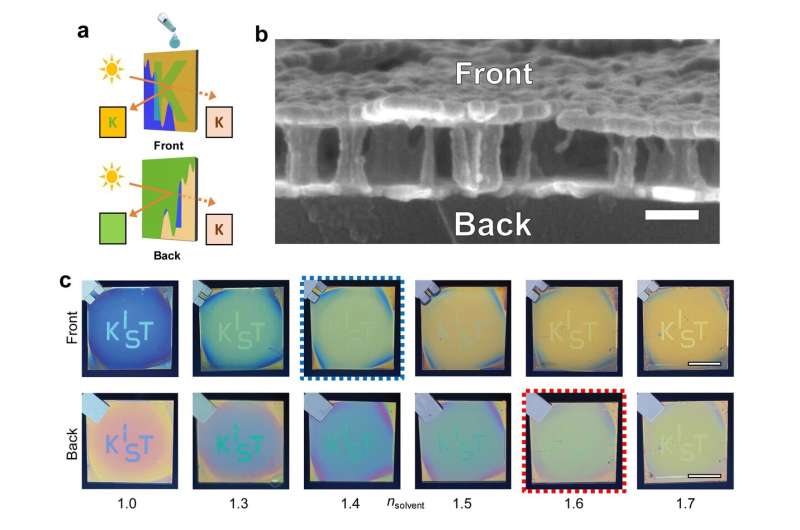a, Conceptual illustration of direction-sensitive asymmetric optical camouflage by tuneable optical Janus effect b, SEM images of the nanostructured Au film and CYTOP nanopillars. Scale bars, 200 nm. c, Photographs of solvent-immersed etalon demonstrating asymmetric message hiding seen from the frontside (upper) and backside (lower) under media of n = 1.0 (air), nsolvent = 1.3, 1.4, 1.5, 1.6, and 1.7 (solvents). Scale bars, 1 cm. Credit: Taehyun Kim, Eui-Sang Yu, Young-Gyu Bae, Jongsu Lee, In Soo Kim, Seok Chung, Seung-Yeol Lee, and Yong-Sang Ryu
In modern optics, a variety of nanoscale materials and their localisation have been examined, as they lead to novel optical effects. Viewing a direction sensitive information display utilizing the optical Janus effect has attracted great attention owing to its dynamic operation scheme which allows for discriminative information delivery. However, the integration of nano-materials within multiple layers limit their application in dynamic and real-time color tuning.
In a new paper published in Light Science & Applications, a team of scientists, led by senior researcher Yong-Sang Ryu (Sensor System Research Center, Korea Institute of Science and Technology, Republic of Korea) & Professor Seung-Yeol Lee (School of Electronics Engineering, Kyungpook National University, Republic of Korea) and co-workers developed a liquid-permeable translucent mirror to achieve asymmetric reflective color contrast depending on the viewing direction. Based on simple and cost-effective metal-dielectric-metal (MDM) films, they designed an optical device which is capable of displaying distinct colors as well as messages with respect to viewing directions.
This optical device is comprised of nanoscale air voids in the dielectric film space which play a key role in color tuning via an infiltration of exposed liquids into the optical hotspots. Because the physicochemical properties of the dielectric films lead color creations in visible ranges, based on a thorough understanding of optical phenomena depending on the comprising nanostructures of MDM films, reflective color tuning in a varying refractive index of surrounding solvents was realized. These scientists summarize the optical properties of their device:
"We describe the design of a transreflective etalon that produces directionally asymmetric reflective color depending on the direction of incident light. And we discovered that the precise control of the physicochemical properties of the comprising films led to creation of viewing-direction sensitive asymmetric information encryption varying both by nanostructures and surrounding liquids. These results suggest that the manipulation of film geometries enables us not only to display the color contrast but to hide viewing-direction-sensitive message encryption via this optical camouflage phenomenon."
"Moving forward, bidirectional display of two different tuneable messages/images appears to be a tangible goal in the next step to allow for a wider range of photonic applications, including dynamic/informative color filters, smart windows, optical switches, double-side color displays, optical data storage devices, and anti-counterfeiting devices. Furthermore, as the proposed fabrication process is compatible with large-area substrates, the design can be applied to optical-sensing platforms," the scientists propose.
More information: Taehyun Kim et al, Asymmetric optical camouflage: tuneable reflective colour accompanied by the optical Janus effect, Light: Science & Applications (2020). DOI: 10.1038/s41377-020-00413-5
Journal information: Light: Science & Applications
Provided by Chinese Academy of Sciences
























